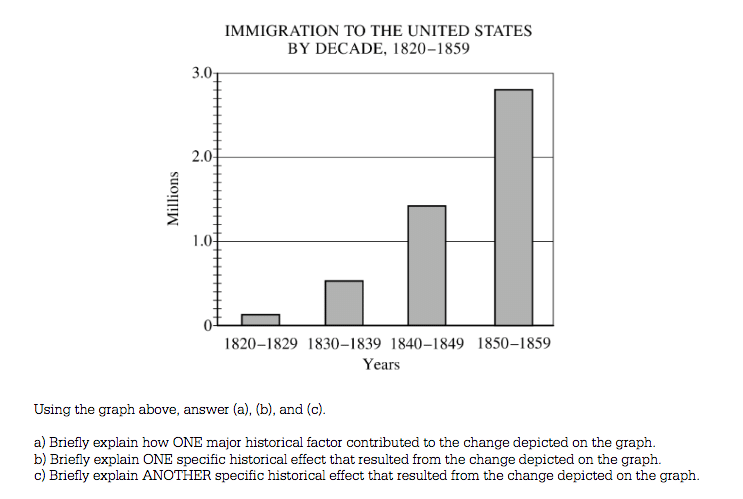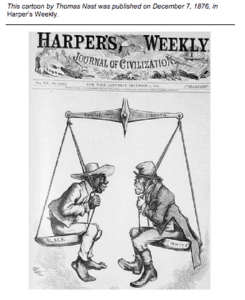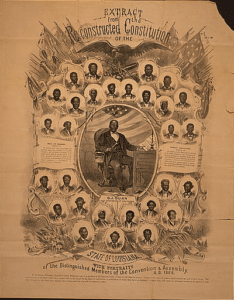
The APUSH Short Answer is one of the newer components of the APUSH exam. The purpose of the short answer question is to combine the content knowledge you will display in the Multiple Choice section, while asking you to demonstrate key historical thinking skills. The short answers make up 20% of your total score, making them the third most important component of your overall APUSH exam score. Keep reading for some practice APUSH short answer questions – and the scoring guidelines to match!
What’s the format for the short answers?
For the short answers, you will be asked a series of short questions related to some historical topic. Some questions may include historical documents, charts, or tables. Regardless of the content you receive to answer the question, the goal is the same: you are to demonstrate what you know best. You will receive a point for every complete and correct response you give. You could receive partial credit (see Official Scoring Guide), but you want to receive maximize points: answer all parts of the question.
Here’s an example of a short answer question from the 2016 APUSH exam.

From APUSH 2016 Exam.
What will short answers ask me to do?
There is no specific format a short answer question will take: some may have sources for you to draw upon, others may not. But the overarching point of a short answer is for you to show what you know. Generally speaking, the short answers will ask you to demonstrate one of the following types of thinking:
- Explain
- Compare and contrast
- Extend
Explaining will require you to describe as many relevant pieces of information as you can to answer the question. Comparing and contrasting will require you to look for similarities (comparing) and differences (contrasting) between two different viewpoints or events (this will likely be asked if you are looking at two different documents from two opposing points of view). Finally, extending will require you to use the information given to you in the prompt and draw on knowledge outside of the prompt to answer the question.
If we use the 2016 example above to demonstrate these concepts, it seems obvious that prompts (a) – (c) ask you to explain. However, imagine if this short answer also included the image below:

From Stanford History Education Group. Thomas Nast, Cartoon, Harper’s Weekly, December 7, 1876
You can now imagine several different questions that would ask you to compare and contrast the information presented in the graph, as well as extend the themes in the two sources to events beyond those directly mentioned. From the table below, you can see how the types of thinking overlap.
| Sample Questions |
|---|
| Briefly explain how ONE specific historical event or development from the period 1820-1880 could be used to support the sentiment expressed in the political cartoon |
| Identify ONE specific example from history about anti-Irish immigration sentiment |
Below, I will give three short answer examples for you to practice; check your responses against the scoring guide provided at the end of the blog post. Remember that your goal is to demonstrate what you know through a combination of explaining, comparing and contrasting, and extending
Happy studying!
APUSH Short Answer Question Examples
Example Short Answer Question 1
Excerpted from The DBQ Project: How Democratic Was Andrew Jackson?
“The present Bank of the United States…enjoys an exclusive privilege of banking…almost a monopoly of the foreign and domestic exchange. It appears that more than a fourth part of the stock is held by foreigners and the (rest) is held by a few hundred of our own citizens, chiefly of the richest class. Of the twenty-five directors of this bank five are chosen by the government and twenty by citizen stockholders…It is easy to conceive that great evils to our country…might flow from such a concentration of power in the hands of a few men irresponsible to the people…”
Andrew Jackson’s Bank Veto Message to Congress July 10, 1832
“(President Jackson’s message) extends the grasp of (the chief executive) over every power of the government….It sows…the seeds of jealousy and ill-will against the government of which its author is the official head. It raises a cry that liberty is in danger, at the very moment when it puts forth claims to powers heretofore unknown and unheard of… It manifestly seeks to inflame the poor against the rich, it wantonly attacks whole classes of people, for the purposes of turning against them the prejudices and resentments of the other classes.”
Daniel Webster’s Reply to Andrew Jackson’s Bank Veto Message July 11, 1832
Answer (a), (b), and (c)
(a) Briefly describe ONE significant difference between Jackson’s interpretation of government powers as expressed in his message to Congress and Webster’s.
(b) Briefly explain how ONE specific historical event or development from the period 1790-1840 could be used to support the sentiment expressed in Jackson’s message.
(c) Briefly explain how ONE specific historical event or development from the period 1790-1840 could be used to support the sentiment expressed in Webster’s message.
Example Short Answer Question 2
Answer (a), (b), and (c)
(a) Briefly explain ONE important goal of the Missouri Compromise of 1820.
(b) Briefly explain ONE reason why this compromise was successful in achieving the goal you outlined in part (a).
(c) Briefly explain ONE reason why this compromise was unsuccessful in achieving the goal you outlined in part (a).
Example Short Answer Question 3

From the Library of Congress
Answer questions (a), (b), and (c)
(a) Briefly explain how ONE major historical factor contributed to creation of the image.
(b) Briefly explain ONE historical response to the image.
(c) Briefly explain ONE historical response to the image that diverges from what you wrote in part (b).
Brief Answer Key
Short Answer Question 1
Examples of responses to (a) that would earn the point:
What’s most important is that you connect your response about the two different interpretations to views about the role and power of the government.
Examples of responses to (b) that would earn the point:
Historical events that show how centralized power (i.e. the BUS) was harmful to Westerners, agrarians, and other “common men” would support Jackson’s point of view.
Examples of responses to (c) that would earn the point:
Historical events that show how unified, centralized power was beneficial to the United States, as a whole – and Northerners like Webster in particular – would support Webster’s point of view.
Short Answer Question 2
Examples of responses to (a) that would earn the point:
Appease southern slaveholders in Congress
Big idea for the Missouri Compromise: have a clear idea of what new territories would be admitted as slave and free states.
Examples of responses to (b) that would earn the point:
For a short period of time, the Missouri Compromise did what it intended to do.
Examples of responses to (c) that would earn the point:
The most important idea is that the Missouri Compromise did not deal with the issue at hand: the expansion of slaveholding power in the United States government.
Short Answer Question 3
Examples of responses to (a) that would earn the point:
These black legislators in Louisiana were the result of Radical Reconstruction.
Examples of responses to (b/c) that would earn the point:
A discussion of the political and/or social support and backlash for black voting rights and legislative rights would be appropriate.



